Planning Your Kitchen: Five Tools for Layout
In this excerpt from Build Like a Pro: Remodeling a Kitchen, designer and builder Sam Clark shares 5 key concepts to help you find the best configuration for cabinets, counters and appliances.
As you begin to make more detailed plans from your preliminary sketches, you want to be sure you will be making a highly functional kitchen, one that will be pleasant, efficient, and physically comfortable to work in. Finding good-quality and appropriate cabinets, appliances, doors, and other items is important. But putting them in just the right configuration, with just the right dimensions, is even more crucial. Kitchen researchers and designers, beginning in the 1920s, developed some useful concepts for making these choices. Here are some of the ideas that I have found most useful.
Pro Tip
Don’t assume the window has to be over the sink; you may want storage there. The window can be above the main work counter or elsewhere.
In detail
In a tight space, inches matter. A 30-in.-wide mix-center counter feels much bigger than a 27-in. one, and a 33-in. one feels positively huge. If passageways are narrow, recessing the refrigerator 3 in. can make a big difference. Taking pains over small dimensions will definitely pay off.
What can go wrong
Often a tight kitchen layout will work perfectly for most meals but show its limitations when cooking an elaborate meal for a big group. If so, sometimes a drop-leaf or a rolling cart can be mobilized for more work area, or the kitchen table can become a temporary workplace
1. The “work center” concept
Perhaps the most important of these concepts is that of the work center, which goes back to the early days of industrial engineering and the work of Frank Gilbreth. The basic idea is that any work station—whether a carpenter’s bench or a kitchen work area—should be set up to accommodate the specific details of the work to be performed. Work surfaces should be placed at the correct height and made of the most appropriate materials. Tools and supplies that go with the work should be handy but not in the way. And the best and most convenient storage locations should be allocated to the tools and supplies used most frequently.
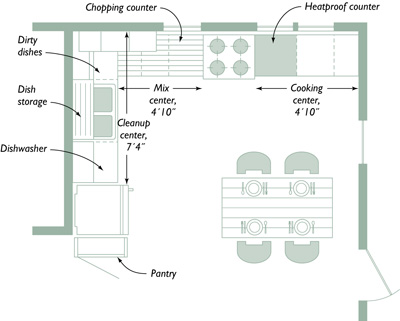
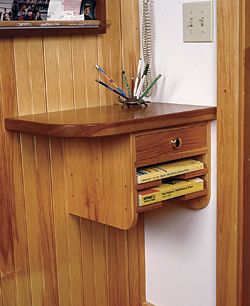 A kitchen can have a simple phone and message area.
A kitchen can have a simple phone and message area.
Early kitchen researchers defined three pri-mary kitchen work centers reflecting three different sorts of kitchen work: cleanup, mixing, and cooking. The cleanup center includes the sink, a place to stack dirty dishes, probably a place for a drainboard, cleaning supplies, and often storage for everyday dishes. Today, the cleanup center would usually include a dishwasher. A trash can is essential, and the countertop should be waterproof or water-resistant. A cleanup center may also be a place for good preliminary recycling. The mix center (or food-preparation center) should be organized around the premier work counter, with easy access to favorite knives, utensils, bowls, and small appliances, as well as to the most frequently used supplies, such as oil, salt, flour, and such. Sometimes butcher block is used here, though many people prefer movable chopping boards. The cooking center includes the stove, another counter, a heatproof place to set down hot dishes, and tools and supplies used primarily at the stove, such as pots, pans, lids, spatulas, pot holders, and perhaps spices.
Today we cook very differently than early researchers did, but these three basic and relatively distinct work areas are still helpful design building blocks. Many designers rightly add a fourth function, the serving center, which is often near the table. It has a place to set hot pans, and it houses serving dishes, perhaps the good tableware, and napkins. Many cooks also define other centers for inclusion, particularly a baking center. A message center might be as simple as a wall phone with a pad of paper, but it could be large enough to include a desk with a computer for doing homework and paying bills. Your kitchen might be large enough to include a recycling center, where newspaper, bottles, and other recyclables can be organized on their way out of the house. As I survey and evaluate any kitchen layout, locating the basic work centers on the plan, I have a specific range of dimensions in mind.
Cleanup center
I often start with the cleanup center. It has, of course, a sink, usually (but not always) 25 in. or 33 in. wide. There is at least a 2-ft.-wide counter on one side for dirty dishes, and a similar 20-in. or wider counter on the other side for a drainboard. A dishwasher is 24 in. wide; in most new kitchens, a space for it will be needed beneath one of these side counters.
Mix center:
For some very tidy cooks, this food-prep center can be as little as 30 in. wide but more often is 36 in. to 60 in. wide. It should be handy to both sink and stove. It might be an island, but it’s often a counter between cleanup and cooking. It can’t be the same as the counters at the sink, which are routinely covered with dishes, nor any other counter that’s occupied by a microwave, big mixer, or other gear.
Cooking center:
Most stoves are 30 in. wide, though some commercial models are 36 in. or more. If a hood is desired, it’s helpful (though not essential) to have the stove on or near an outside wall. The cooking center should have its own counter. This counter should be at least two feet wide, preferably more. It is often the place where a second cook can work.
Don’t position the side of a stove right up against a wall. The heat from the burners can burn the wall. Also, avoid a location adjacent to a hallway or walking space, where kids or others walking by might accidentally knock over a hot pan. If the stove is in an island or a peninsula, make sure it is protected at the rear, either with a raised back or by a counter at least 9 in. wide.
The refrigerator:
Although the refrigerator is sometimes included with one or another work center, it makes more sense to think of it as a separate element. A refrigerator is big and bulky, so it doesn’t work well in the middle of a run of cabinets. It’s usually placed at the end of a run, sometimes in combination with a tall pantry unit of some kind (see the drawing on p. 21). It’s important to have some counter space nearby to place shopping bags on for loading the fridge.
If I can include all of these essential elements on my plan, I know a good layout will be possible.
2. The food-flow idea
When possible, it’s good to locate the work centers in the right sequence, based on the way food is processed. To oversimplify, food comes in the back door, gets stored in a pantry or the fridge, gets taken out again, is washed up at the sink, chopped up at the mix center, cooked, then served. If the work centers are more or less in that order, kitchen work will be easier, with fewer wasted steps.
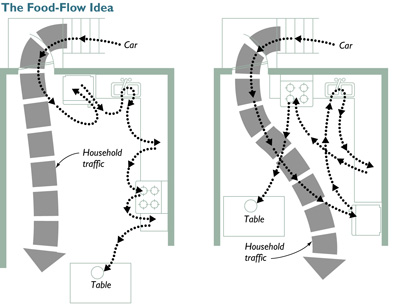
Pro Tip
A small kitchen has advantages; less walking back and forth makes food preparation both easier and faster.
In Detail
Sometimes storage can be recessed into walls. For example, a pantry can be as
little as 5 in. to 7 in. deep.
3. Standard kitchen layouts
Most of us are familiar with the standard kitchen layouts that have evolved: the U, L, galley, one-wall, island, and peninsula. The peninsula, I suppose, is simply any layout without a wall behind some of the cabinets, while both the peninsula and island schemes can be thought of as variations on the U-layout. Although there are endless variations and elaborations, most kitchens fall into one of these models.
U-layouts make a lot of sense. They concentrate a complete work area in a compact space, with little through traffic. The peninsula and island versions allow for sociability, and they often connect the workspace to the dining or family space nearby.
The L-layout is simple, handy, and efficient. It’s also compact in a special sense. Where the U-layout requires a distinct space of its own, an L-shaped kitchen can be simply the edge of a larger space. For that reason a small space often calls for an
L-layout. The galley layout is quite efficient if the aisle is 3 ft. to 5 ft. wide. The disadvantage is that the aisle is usually a traffic lane, which can disrupt the cook. The one-wall layout is not ideal; it results in a lot of walking and would be used where a better option is impossible.

4. The work-triangle test
The work triangle, devised in the early 1950s as a test for kitchen layouts in government-financed housing, specifies an optimal relationship between the sink, stove, and refrigerator. The idea is that if these are too far apart, there will be needless extra steps while cooking. If they are too close together, work centers will overlap, and you’ll have to constantly walk around the appliances to get to your work area.
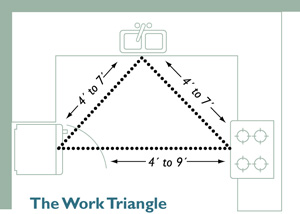
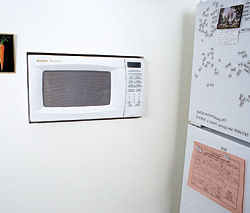
A pantry this size can be buried in the wall. I have often recessed refrigerators, shelf units, and microwaves into walls to save space.
5. The power-kitchen idea
In kitchen remodeling, it’s sometimes impossible to devise a perfect layout. This has been true of many of the houses I’ve lived in and fixed up. But there is another insight from kitchen research that I’ve found useful. Most of the little journeys in cooking are from the sink to the mix center and back, from the stove to the mix center and back, or between the sink and stove. There are significantly fewer trips to the fridge, table, pantry, or back door. That means that if you can establish a mix center or main work counter that is within about two or three steps of both sink and stove, and maybe even directly between them, the kitchen can be efficient, even if other features of the layout are less than ideal.
Put another way, you can live with having the fridge, pantry, or table a short walk away, or having the basic units out of the ideal “food-flow” order. But if the main work counter is a hike from the sink or stove, or if those appliances are too widely spaced, your kitchen will be inconvenient to use no matter what else you do.
Power Kitchen
An imperfect layout can work as long as there is a nice generous counter space handy to both sink and cooktop. Here there is no counter space at the stove, the left sink counter is cramped, and the refrigerator is too far from the food prep-area. But the main food prep counter–the power-kitchen area–is big enough, is very handy to both sink and stove, and has suppplies, tools, and a trash can near at hand. So it is still quite an efficient kitchen to work in.
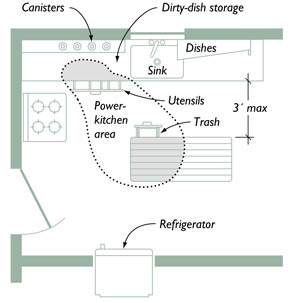
Sam Clark has been a designer-builder for over 25 years, specializing in kitchen design, accessible design, and cabinetmaking. Photos by Andrew Kline; drawings by: Mario Ferro
Fine Homebuilding Recommended Products
Fine Homebuilding receives a commission for items purchased through links on this site, including Amazon Associates and other affiliate advertising programs.
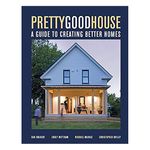
Pretty Good House

All New Bathroom Ideas that Work

A House Needs to Breathe...Or Does It?: An Introduction to Building Science

























